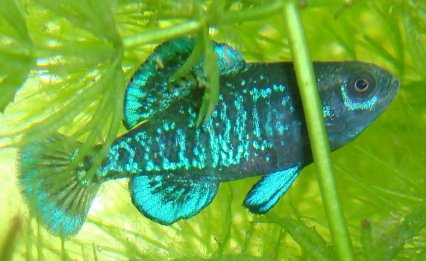February 17 saw the implementation of the Prohibition of Keeping and Release of Live Fish (specified species) (England) Order 2014. The new legislation, which supercedes former prohibitions, affects everyone from hobbyist to importer, and brings in a fresh 'white list' of exactly which species we can now keep. Nathan Hill reports...
The idea behind the legislation is one of protecting native flora and fauna, hence it being handled by DEFRA.
For those familiar with the old ILFA system, general licences still exist, only now they extend to both the end user (hobbyist) and retailers selling livestock.
Under the older system, fewer species were listed, and only individuals (hobbyists) were covered under a general licence, with retailers needing to apply for their own licences to sell specific species.
The new general licence allows anyone to keep certain fish without having to apply for individual licences. That means that both stores and hobbyists can keep any of the fish listed — and some more besides.
Fish that are exempted from the order are all natives to England and Wales as well as Common carp (including all variants), Goldfish (including all variants), Ide or Orfe, and Rainbow trout.

There is one interesting caveat involving Acipenser and Huso sturgeon as well as Grass carp, which are covered by a general licence if kept in aquaria or 'garden ponds'. However, a garden pond is here defined as a 'discrete, isolated body of water, not exceeding one acre in size, on private residential premises, established and used specifically for the ornamental display of fish. Such ponds must pose no risk of escape of fish into the wild, and must not be used for fishing or any commercial purposes related to fish rearing or dealing.'
What’s interesting there is that given the current climatic issues sweeping England and Wales, one has to wonder whether there are really any ponds that can ensure their fish will not escape into the wild. Anyone currently with a garden underwater will, we assume, be automatically disqualified from keeping these fish.
Marine fish remain entirely unaffected by the legislation, and so all salty transactions remain 'business as usual'.
Who’s gone?
The white list of permissible fish spans literally everything we are allowed to keep, and is categorised to genus level, except on those genera where some species are exempted, or where only certain species are allowed.
The general consensus is that if a fish is tropical, it’s safe, and only potentially invasive or disease vector species are gone. But that’s not to say there aren’t some notable gaps and reasons to frown.

The first absences I noted were the numerous Rhinogobius species. Confirmed as legitimate on the list are just three: R. cliffordpopei, R. duospilus (pictured above) and R. rubromaculatus, but no mention is made of the likes of R. zhoui or any of the other 50-plus species. For now at least, it would appear that those fish are gone. This appears in stark contrast to the numerous Asiatic loaches, which all indulge similar if not more extreme temperature ranges than Rhinogobius, but have all made it on to the approved listing.

Some other fish that are gone are, from this author’s point of view, a welcome removal. Bowfins, Amia calva, (pictured above by Stan Shebs, Creative Commons) no longer appear, nor do things like Tachysurus fulvidraco. Catlocarpio is absent (thank god) as are any of the North American Shiners besides Notropis chrosomus (Rainbow shiners). A few public aquaria may have woes, given that the likes of Polyodon and Psephurus Paddlefish are out, along with all Lepisosteus gars aside the Florida gar, Lepisosteus platyrhincus.
Astute readers of the list may have moments of panic when they see certain names omitted, and this warrants further investigation. Of alarming note was the genus Sahyadria, or what you and I would know as Denison’s barb. The name was changed late last year but it would seem that the FHI haven’t caught up with this change. Should this be cause for concern? Can we expect ramifications when importing this fish?
Well, no is the answer. Speaking to Alasdair Scott at CEFAS, I’m informed that there are measures in place to cope with name changes. In a nutshell, some fish that are universally accepted as trade familiars — such as Denison’s — are still covered by virtue of being accepted under the former name of Puntius. Unless there happened to be something explicitly written into the Puntius genera that said the Denison’s couldn’t be traded, then they’d still be considered okay to import.
The same applies to 'incertae sedis' fish, those that have no ultimate taxonomic designation. In their instances, they can be brought in under the names that they have been tentatively given. So for argument’s sake, if a new Corydoras type of catfish is found, and we don’t know whether it’s Brochis, Scleromystax or Corydoras, then assuming it’s given the 'Corydoras' moniker for the time being, then it’s safe to come in under that banner.
This point will be of particular interest to Loricariid fans, where new cats are often picked up, dubbed with an 'L' number, not even given a genus, and subsequently imported. As we can grant that the fish will likely be under one of the many recognised and accepted 'L' number genera, then it’ll be fine to bring in.
There are a couple of unusual additions, too. Given that the list is designed to omit potential disease vectors and invasives, I was surprised to see the genus of Aphanius appear, considering that it contains the likes of A. dispar and A. apodus. A. dispar especially is capable of withstanding temperatures down to 4°C.

Likewise, some Elassoma have appeared, with E. evergladei, E. gilbert (pictured above by Okiimiru, Creative Commons) and E. okefenokee — another 4°C species.
How do we get additions, or fish removed?
Of concern to all is how new fish can be added to the list, especially for those importers of rare and unusual varieties. In order to add a fish genus, and assuming a species isn’t covered elsewhere under an older genus ascription, it is down to the importer to run a risk assessment, showing that the fish poses no risk to UK natives from its introduction to pond or aquaria. Risk assessments are then scrutinsed by the Fish Health Inspectorate and either the fish will be rejected, or added to the list.
There’s also the opportunity to remove species or genera, but again this is subject to risk assessing, and stops any rogue fish health inspectors from whimsically slashing the list. It also stops anti-trade bodies from tearing in to the selection and demanding that fish be removed left right and centre on the flimsiest of premises. All risk assessments will be judged on their merits.
This leads to a point worth discussion: no fish is technically banned forever from the country, but any exclusion at this point is subject to risk assessments. The list has a certain malleability that allows it to be reshaped as time goes by, and so it’s not the case that someone can simply glance over the currently accepted species, spot an omission, and declare that fish a lifelong illegal that will never enter the country.
In the meantime, you can find the complete list of fish (as of February 18) on the DEFRA site and if you spot any obvious errors or absent fish, then you should email the Fish Health Inspectorate at CEFAS on [email protected], or telephone 01305 206700.
For now, I think it’s safe to say there will be a little bit of bedding in required, and some teething issues to iron out, but on the whole the list makes a welcome relief after months of apprehension. All retailers and importers should scan the list thoroughly, however, because if you’re hoping to import something that isn’t on there, and can’t be accounted for with an earlier taxonomic name, then you can’t import it without appropriate licensing.
*This article was amended to read 'England' in the title line as opposed to the original 'UK'.*
Why not take out a subscription to Practical Fishkeeping magazine? See our latest subscription offer.
Don't forget that PFK is now available to download on the iPad/iPhone.







